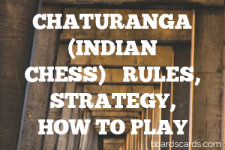Parcheesi: Unveiling Rules, Winning Strategies, and How to Play
Introduction
Parcheesi is a classic game that has been enjoyed by generations of players, increasingly including in the US gaming communities. Parcheesi is a strategy board game that originated in India and is known for its unique blend of strategy and chance.

The game is played on a cross-shaped board with each player having four pieces to move around the board based on the roll of dice. The objective of the game is to move all of your pieces around the board and into your home column before your opponents do.
The game of Parcheesi has a long history dating back to ancient times. It is believed to have been derived from the Indian game of Pachisi, which was played as far back as the 6th century AD. The game was later adapted and popularized in the West by the Parker Brothers under the name Parcheesi.
To play Parcheesi, you will need a Parcheesi board, 16 playing pieces (4 each of 4 different colors), and two dice. The game can be played by 2 to 4 players making it a great choice, I find, for family game nights or social gatherings.
There are some similar games like Trouble and Sorry that have symmetrical piece-moving mechanics, which I’ve also written guides on!
Quick Tip
One quick tip to win at Parcheesi is to always keep your pieces spread out on the board. This will increase your chances of landing on your opponent’s pieces and sending them back to their starting area.
Rules for Playing Parcheesi
- Each player starts with all four of their pieces in their respective starting area.
- Players take turns rolling the two dice and moving their pieces around the board. The number of spaces a piece can move is determined by the roll of the dice.
- If a player rolls doubles, they get to take another turn.
- If a player’s piece lands on a space occupied by an opponent’s piece, the opponent’s piece is sent back to their starting area.
- The first player to move all of their pieces around the board and into their home column wins the game.
These are the official rules of Parcheesi, but like many board games, players often introduce their own ‘house rules’ to add a twist to the game. For example, some players might allow a piece to move backwards or introduce a rule where a piece cannot enter the home column unless it lands there by exact count.
How to Play Parcheesi
Setup
At the start of the game, each player places their four pieces in their respective starting area. The players then decide who goes first, usually by rolling the dice with the highest roll going first.
Gameplay
On a player’s turn, they roll the two dice and move their pieces around the board. The number of spaces a piece can move is determined by the roll of the dice. A player can choose to move one piece the total number of spaces rolled or split the roll between two pieces. For example, if a player rolls a 5 and a 3, they can move one piece 8 spaces or move one piece 5 spaces and another piece 3 spaces.
End of the Game
The game ends when one player has moved all of their pieces around the board and into their home column. That player is declared the winner of the game.
How to Win at Parcheesi
Winning at Parcheesi requires a combination of strategy and luck. Here are some strategies that can help you win the game:
- Spread out your pieces: Keeping your pieces spread out on the board increases your chances of landing on your opponent’s pieces and sending them back to their starting area.
- Use your rolls wisely: If you roll a high number, consider using it to move a piece that is far from your home column. If you roll a low number, consider using it to move a piece that is close to your home column.
- Block your opponents: If you have two pieces on the same space, your opponents cannot pass that space. Use this to your advantage to block your opponents and slow down their progress.
- Take advantage of doubles: If you roll doubles, you get to take another turn. Use this to your advantage to move your pieces quickly around the board.
Best Strategies for Playing Parcheesi
While luck plays a role in Parcheesi, there are also strategies that can increase your chances of winning. Here are some of the best strategies for playing Parcheesi:
- Keep your pieces safe: Try to keep your pieces on safe spaces (the spaces marked with a circle) whenever possible. This will protect them from being sent back to the starting area by your opponents.
- Plan your moves: Before you roll the dice, consider all possible outcomes and plan your moves accordingly. This will help you make the best use of your rolls.
- Be aggressive: Don’t be afraid to send your opponents’ pieces back to their starting area. This will slow down their progress and give you an advantage.
- Be patient: Parcheesi is a game of patience. Don’t rush to move your pieces into your home column. Instead, wait for the right moment to make your move.
Scenarios
There are many different scenarios that can occur in a game of Parcheesi. Here are some common scenarios and how to handle them:
- You have a piece close to your home column but you roll a number that is too high: In this case, you might want to move another piece instead. This will allow you to move your close piece into your home column on your next turn.
- Your opponent has a piece on a safe space: In this case, you might want to move your pieces to block your opponent’s path. This will force your opponent to move their piece off the safe space.
- You have two pieces on the same space: In this case, you might want to keep your pieces together to block your opponents. However, be careful not to leave your other pieces vulnerable.
- You roll doubles: In this case, you should take advantage of your extra turn to move your pieces quickly around the board.
Frequently Asked Questions about Playing Parcheesi
Can I move my pieces backwards? According to the official rules, pieces can only move forwards. However, some players introduce a ‘house rule’ that allows pieces to move backwards.
External Links
Play Parcheesi Online (free, but registration required)
Parcheesi Review and Gameplay Demo [Video]

Eve Brownlee was a gamer before gaming communities on the internet were a thing. Eve grew up playing traditional, standard deck card games like Rummy and Bezique, taking an interest in the classics Backgammon and Chess. Parlor card games like Bridge continue to keep Eve active in the community. After a long career, primarily in horticulture for USDA in Maryland, Eve now travels and writes on The Pineapple (pineapples.info) and contributes to Quora/Pinterest topics. Contact Eve via email.



